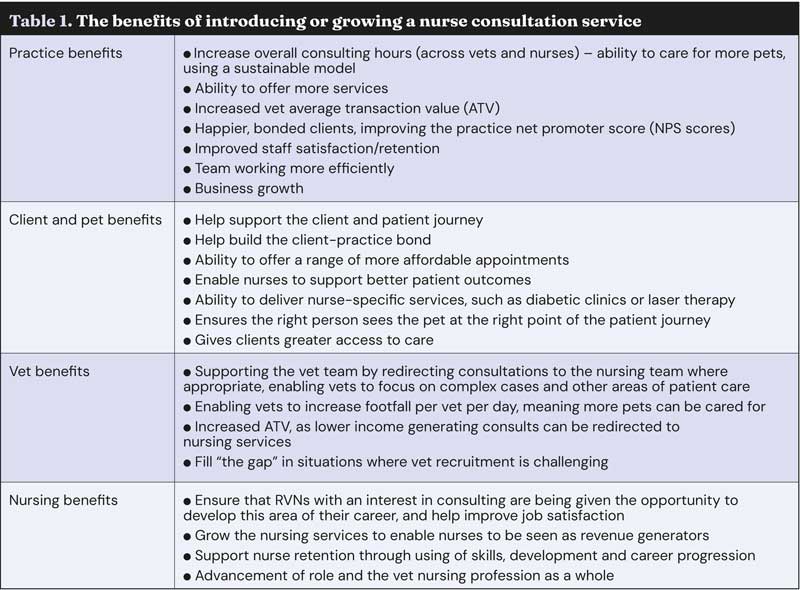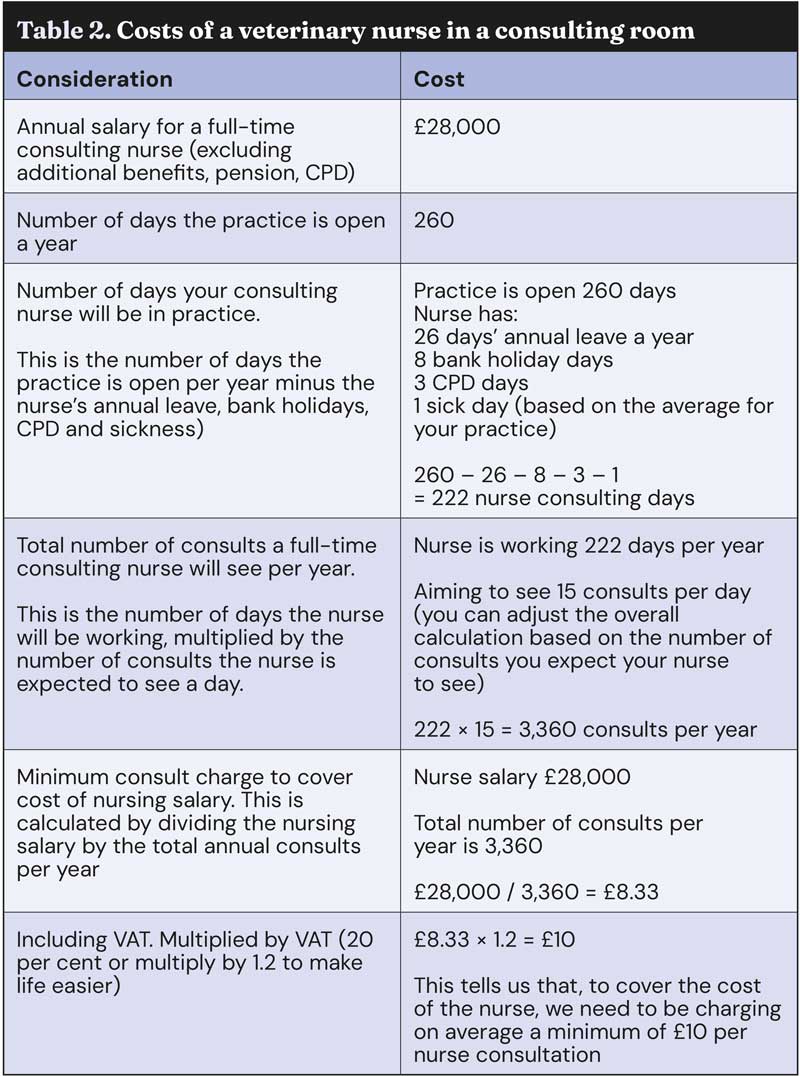15 Apr 2025

Image: S Fanti/peopleimages.com / Adobe Stock
So, you want to set up a nurse consultation service, but despite the many benefits (Table 1) practices often struggle to get them off the ground, resulting in vets seeing cases that could be seen by a nurse and nurses feeling underutilised, lacking fulfilment in their role.
While the range of nurse consultation services you choose to provide will depend on your own individual practice, taking into consideration caseload, practice layout (number of consulting rooms), staffing levels and staff experience, we should proactively being looking for opportunities where vets are not seeing patients that could and should be seen by a nurse, such as admitting and discharging routine cases, or performing blood tests, nail clips, anal gland expression, most second vaccines and blood pressure monitoring.
A practice that moves to an operational model, optimising workflow efficiencies and utilising the role of the veterinary nurse, will help free up vet time, unlocking their ability to spend more time with complex cases, care for more patients by increasing caseload and contribute to the financial health of the business through charging appropriately for both vet and nursing services.

Some common reasons that nurse consultations are not introduced include the following.
Operational considerations require the practice to review what is needed to ensure its service provision runs smoothly.
A big operational consideration in veterinary practice is consulting room availability, being able to use the space most efficiently to care for as many pets as possible; for example, if a practice has one consulting room, review when that room is not being used for vet consultations. This may be when the vet is performing surgical procedures between a certain timeframe.
If we presume the vet is operating between 12pm and 3pm, could the practice deliver nursing services in that consulting room between noon and 2:30pm? Based on 15-minute consultations, this would give the practice an additional 10 consulting slots per day, enabling the client care team to book nursing tasks with the nursing team and reduce these being booked with a vet.
It is understood that in many small, one-vet practices the nurse is needed to help with surgical procedures. This raises the question: is there a benefit to recruiting a dedicated, part-time consulting nurse who works Monday to Friday 12pm to 3pm?
In my opinion, there are specific points in any patient journey when the right person to see is a veterinary nurse.
When reviewing whether to introduce a nurse consulting service, the practice needs to review its current caseload. Are vets seeing nursing consults due to lack of vet-only cases or are vets unable to focus on the more challenging cases because their time is being taken up seeing work that should be seen by a nurse?
I did some work looking at a cross-sectional view of a group of primary care practices’ consulting diaries. On average, a full-time consulting vet was seeing five appointments a day that could and should be seen by their nursing team.
If you apply this to a practice with three, full-time consulting vets, those three vets are generating 15 consults per day that could be seen by a nurse; that’s before they even consider the development and growth of nurse-specific services, such as disease-focused clinics.
In this scenario, a practice that chooses not to provide a nursing service will be paying one vet a day to see nurse consultations, impacting its availability to see higher-value, more complex cases, reducing overall customer footfall and impacting client and revenue growth.
Sometimes, a practice really wants to introduce a new service, but doesn’t seem to have enough staff.
Reviewing workflow efficiency is an important part of launching a new service, and answering a few questions can help:
It may be that the rota and diary need to be amended to ensure you have the right people in at the right time, or it may be that you need to create a business case to recruit an additional person.
Practices may be worried that a nurse consultation service could result in vets seeing a reduced number of appointments, resulting in vets feeling demotivated – particularly when we consider that, on average, a nurse can see an additional 18 to 20 consultations on a daily basis (Lambert, 2022).
The impact that this has on the vet consultation list would very much depend on current caseload, and the practice’s ability to attract new clients, as well as the current staffing levels within the team.
Corah et al (2019) found that approximately half of first opinion, small animal consultations exceeded their allocated time, signifying a growing need in the UK for longer consults or, in my opinion, a review of what is being performed in consultations; for example, a vet has decided a patient needs a blood test and blood pressure performed. If the vet tries to perform this in their 10 to 15-minute appointment, this will undoubtedly result in them overrunning.
A better model would be the vet spending time discussing the case with the client and referring the pet into the nurse consultation stream to complete the diagnostic tasks.
Other benefits of offsetting nurse-specific work to the nursing team are giving vets time to focus on other patients, including working up more complex patients, seeing more consultations or increasing surgical caseload per day.

Veterinary nurses are qualified professionals who can provide a range of services that support the heath care needs of pets. The time allocated to provide care and knowledge through a nursing service should absolutely be charged for, positioning nurses as revenue generators, contributing to the financial health of the practice.
What we need to do is calculate what it costs to provide the nursing service and how much we need to charge our clients to deliver that service. Managing the diary correctly and educating the client care team and clients regarding which appointments are booked in with the nursing team, and which appointments are booked with the vet team, is key to ensuring the nursing service is successful.
The first step, outlined in Table 2, is to understand how much it costs to put a nurse in a consulting room.
The next step is to add overheads, consumables and profit margins based on your individual practice, and calculate what revenue the nurses need to generate to make sure that the service is profitable and sustainable.

It is up to the whole team to get behind any new service, making sure that the client care teams know who to book what with and that vets refer appropriately into any nursing services.
In summary, nurses are responsible for supporting the care of the pets. The successful introduction of a new service hinges on the needs of the business; by identifying where opportunities are, you can focus on creating the right service, so that it: